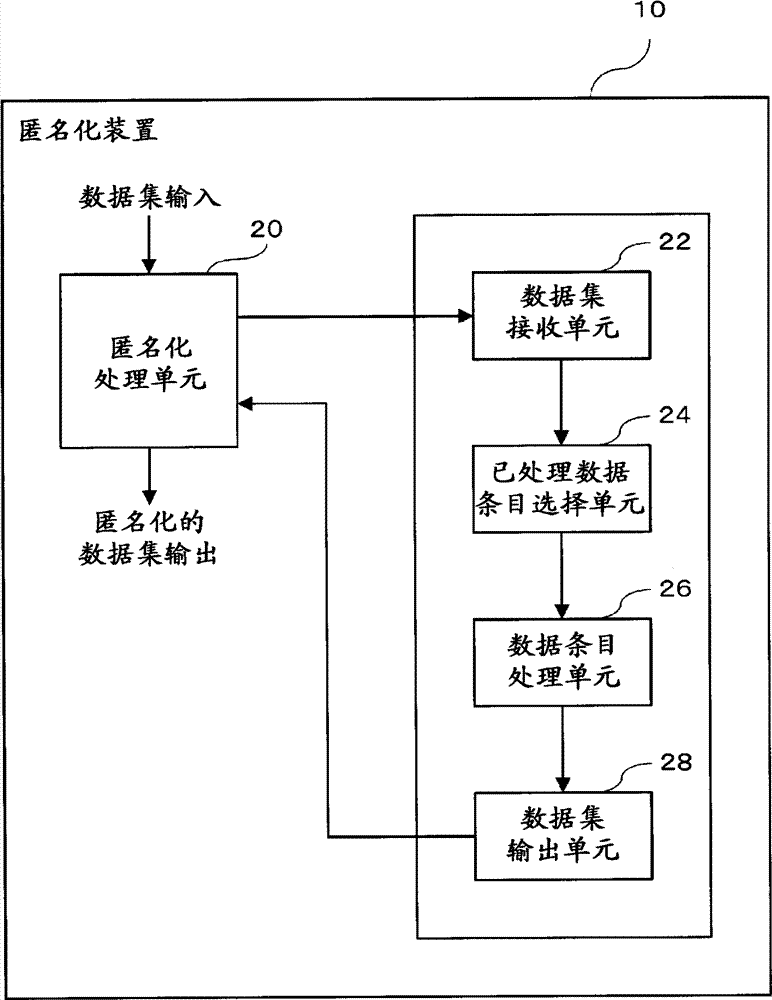De-identification device and de-identification method
An anonymization and anonymity technology, applied in the field of anonymization, can solve the problems of tracking data set characteristics, difficult to observe data set characteristics, information loss and so on
- Summary
- Abstract
- Description
- Claims
- Application Information
AI Technical Summary
Problems solved by technology
Method used
Image
Examples
example 1
[0070] Suppose, after getting Figure 26 After the dataset shown, Figure 27 The data entries shown are input to the anonymization processing unit 20 as additional entries to the data set. Figure 27 The birthplace of the data entry shown is "London", which cannot be based on Figure 24 is generalized according to the generalization rules shown. Therefore, when adding data entries, the criteria for anonymization are not met. Thus, the anonymization processing unit 20 outputs to the data set receiving unit 22 the Figure 26 The dataset after generalization shown and Figure 27 The data entries shown form the dataset.
[0071] The data set receiving unit 22 receives the data set from the anonymization processing unit 20 and outputs the data set to the processed data item selection unit 24 .
[0072] The processed data item selection unit 24 selects, from among the plurality of data items included in the data set, a data item that makes the data set fail to meet the criteri...
example 2
[0079] In this example, as in the example above, assume that after obtaining Figure 26 After the dataset shown, Figure 27 The data entries shown in are input to the anonymization processing unit 20 as additional entries of the data set.
[0080] The data set receiving unit 22 receives the data set from the anonymization processing unit 20 and outputs the data set to the processed data item selection unit 24 .
[0081] The processed data item selection unit 24 selects, from a plurality of data items included in the data set, a data item that, when generalized based on the generalization rule, makes the data set fail to satisfy a predetermined anonymity standard, and makes the data Set at least one data item that satisfies the anonymity criteria, even if that data item is excluded from the data set. An instance of at least one data item that satisfies a predetermined anonymity criterion for a data set (even if the data item is excluded from the data set) is Image 6 Data en...
example 3
[0087] This example is one such that data entries are further added to the dataset processed by Data Processing Example 2. Figure 8 The data set processed by Data Processing Example 2 is shown. In this example, also apply Figure 28 The generalization rule "Europe" is shown. In particular, as Figure 8 As shown, the value of the birthplace of the eleventh entry before the change is passed according to Figure 28 The generalization rules shown in to get "Europe" from "London", where "London" is Figure 27 The value of the birthplace of the data entry shown.
[0088] suppose to get Figure 8 After the dataset shown, Figure 9 The data entries shown are input to the anonymization processing unit 20 as additional entries to the data set. Figure 9 The value of birthplace of the data entry shown is "Paris". When this data entry is generalized by the anonymization processing unit 20, the value of place of birth is generalized to "Europe" and the anonymity criterion is not f...
PUM
 Login to View More
Login to View More Abstract
Description
Claims
Application Information
 Login to View More
Login to View More - R&D
- Intellectual Property
- Life Sciences
- Materials
- Tech Scout
- Unparalleled Data Quality
- Higher Quality Content
- 60% Fewer Hallucinations
Browse by: Latest US Patents, China's latest patents, Technical Efficacy Thesaurus, Application Domain, Technology Topic, Popular Technical Reports.
© 2025 PatSnap. All rights reserved.Legal|Privacy policy|Modern Slavery Act Transparency Statement|Sitemap|About US| Contact US: help@patsnap.com



